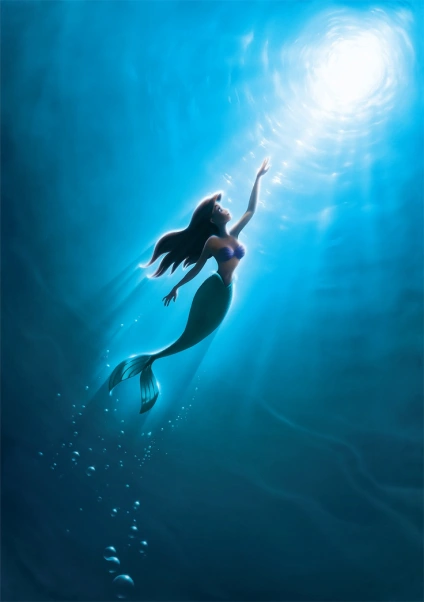 Like the classic Beauty and the Beast, Disney’s The Little Mermaid is stuffed with Christian allegory. Whether the studio, animators, screenwriters, songwriters, voice-actors, and director actually meant to make the movie as an allegory, I highly doubt it, but it is what it is–and after I noticed it, I can never now un-notice it. Here’s what I saw:
Like the classic Beauty and the Beast, Disney’s The Little Mermaid is stuffed with Christian allegory. Whether the studio, animators, screenwriters, songwriters, voice-actors, and director actually meant to make the movie as an allegory, I highly doubt it, but it is what it is–and after I noticed it, I can never now un-notice it. Here’s what I saw:
—
—
—
SPOILER ALERT
—
—
—
- Distrust of the Father: In the Garden of Eden, Adam and Eve became doubtful of God’s care and love. They believed they had to go behind his back. This is also what Ariel does in the film: she thinks she is already an adult, that she can decide good and evil for herself, that she knows better that her dad: King Triton.
- So Ariel is tempted in her own garden: the secret grotto of amazing fruits (treasures) that she’s collected from forbidden areas. Even so, Ariel grasps for more and for the forbidden, even though she has everything a princess enjoys! A loving father, all the royal fare of the sea kingdom. This was exactly Adam and Eve’s condition in Eden, too, “But who cares, no big deal, I want more….”

- Then the serpent appears, and Ariel believes Ursula ( as represented by her twin sea-serpents: eels). This is interesting because we Christians know Satan is not really a serpent, but the snake of Genesis merely represents the tempter. Also, we discover a few things from Ursula:
- She used to live in the Father’s palace, used to serve the King, until she was banished because of her treachery. Sounds awful lot like when Lucifer rebelled in Heaven and was cast down like a lightning bolt.
- The Devil will always deceive, and has always been watching us for weaknesses, to tempt us where it hurts or appeals most. And so Ursula stalks Ariel, watching her every move since her birth. The witch knows all Ariel’s secret desires and uses them against her.
- Ursula, knowing her notorious reputation, fakes her conversion story, saying she is now a saint trying to “help” others! And so the serpent did when it lied to Eve, deceiving Eve into thinking the forbidden fruit was ready to eat now, and not to trust in God’s wisdom that He would give everything good in due time, in divine timing.
- The moment Ursula said that Ariel was “the key to Triton’s (the Father’s) undoing” reminded me that the Devil can never hurt God: Satan and all demons are only creations of God who chose to be ugly and evil. Knowing this immense weakness before God, Satan instead seeks to hurt God’s children: us. Thus, Satan is none other than the Original Child Abuser.
- And whatever gifts Satan tempts us with will always come with major strings such as illness, stupidity, addiction, perversion, hatred, lonesomeness, death. Satan tempts us with false choices; he deceives us into thinking we can actually get some good out of following him, but actually he rigs all the choices with time bombs, he laces all options with poison. He doesn’t want to really help us; he’s only trying to help himself to our destruction. We see this clearly with Ursula’s deal: she only wants to capture Ariel and conquer the Kingdom.
- Because God is love, Satan wants nothing to do with it, and he wants us to be deprived of it. But since he cannot destroy love, he tempts us to abuse it, to refuse it, and to settle for less: Satan tempts us to lust; lust is love distorted. With Ariel, the witch convinces the mermaid that love’s only about superficial appearances: “You’ll have your looks, your pretty face, and don’t forget the power of body language! The men up there don’t like a lot of blabber!”
 When Ariel falls for the lie about love (when we fall for the lie about God), she agrees to the sin. And of course, the sin always costs something. So Ursula’s theft of Ariel’s voice is the consequence of her original sin, and this loss makes Ariel less of herself, as sin always deprives us of our entire beauty. Ariel’s greatest gift was to sing, and now sin silences her song.
When Ariel falls for the lie about love (when we fall for the lie about God), she agrees to the sin. And of course, the sin always costs something. So Ursula’s theft of Ariel’s voice is the consequence of her original sin, and this loss makes Ariel less of herself, as sin always deprives us of our entire beauty. Ariel’s greatest gift was to sing, and now sin silences her song.- Even more, our Original Sin wounded relations between man and woman: we began to use each other, not know each other for our greatest gifts and deepest dreams. And in the film, we see that Eric cannot recognize Ariel, the couple cannot communicate. Love becomes confusing, and incredibly difficult to experience, to choose.
- But God wants us to know that He is love. To do this, God wills to sacrifice, wills to pay the penalty to free us, to REDEEM His children. And so God becomes weak, He descends to the dead (Ursula’s seaweed garden): Satan’s prison. Triton sacrifices himself for Ariel’s freedom (and freedom is the key ingredient to true love).
- But we, man and woman, must still work and sacrifice to make God’s dream come true! In the film, Eric defeats Ursula utterly. Eric is like a type of New Adam, here to undo what the First Adam failed to do: defeat the serpent who deceives the First Eve.* In the Bible, Jesus Christ is the New Adam who does this for us.
- The ship is a traditional symbol of the Church, and this ship, no matter how busted, still spears Satan, as Christ will always steer and guide the ship through her crew of popes and bishops *(just as Eric guides and steers the busted ship to bust the witch). Notice also that Ursula doesn’t even see the ship coming at her; this mimics well how Christ blindsided Satan, defeating evil and death by dying–something so counter-intuitive.
- In the end, the Father always had His childrens’ best interest in store. All we had to do was trust Him and wait patiently. In the film, we discover King Triton always had the power to transform Ariel into a full human being, not some deprived version of a woman that Ursula delivered. In Christianity, we believe that God, our Father, always wanted to transform us, to glorify us, to divinize us! The serpent told Eve that God didn’t want us to be like God, but actually that was God’s dream all along, and that we were already in the image and likeness of God! All that was left was for us to become more and more like our Father, more the humans God meant us to be. Whereas sin makes us less human, deprives us of our greatest dreams: to be like God.

- That about wraps it up. Here are some bonus symbols that didn’t fit into the list above, but are neat anyways:
- Sebastian-the-crab’s full name includes “Ignatius”, which is a pretty big name for Christianity. We have famed saints with that name, such as Ignatius of Antioch, and Ignatius of Loyola (the founder of the Jesuits).
- The sea is traditionally seen as the fallen world of sin. It is unsafe, has unpredictable storms, and was even demonized by the Jews who considered it a place of evil.
- And Eric resembles the lonesome man in Genesis 2:20-23), searching for someone to love, a helper. He falls into a deep sleep and wakes to find woman (Ariel), sitting at his side.

—
Disclaimer: recall all metaphors have weaknesses, as all analogies/allegories do. In this case, King Triton is not a perfect symbol of God (Triton has a few flaws whereas God is flawless). Also, Eric is not quite a fitting symbol of Jesus.

 Not many directors have my full trust in their story telling; besides Christopher Nolan, there is only Mel Gibson. After a decade of recovering and rehabilitation from his downfall, Gibson’s first film since Apocalypto and The Passion of the Christ—
Not many directors have my full trust in their story telling; besides Christopher Nolan, there is only Mel Gibson. After a decade of recovering and rehabilitation from his downfall, Gibson’s first film since Apocalypto and The Passion of the Christ—


 Most of us are familiar with merciful, loving and forgiving Jesus…
Most of us are familiar with merciful, loving and forgiving Jesus…


 —–9) Finally, more about the Turing Test. One of the classes taken enroute my philosophy degree focused on the metaphysics of man, and one of the best texts covering this was
—–9) Finally, more about the Turing Test. One of the classes taken enroute my philosophy degree focused on the metaphysics of man, and one of the best texts covering this was 



![[from W. Norris Clarke's "The One and the Many"]](https://holysmack.files.wordpress.com/2014/11/infinite-regress.jpg?w=549&h=549)






![[above is the 1st page of notes from my Theology 249 class: Introduction to Sacred Scripture.]](https://holysmack.files.wordpress.com/2014/04/sacredscript.png?w=549&h=694)
![[above is my 4th page of notes from my Latin 122 class: Introduction to Ecclesiastical Latin]](https://holysmack.files.wordpress.com/2014/04/latin122.png?w=549&h=689)
![[above is my 4th page of notes from my Philosophy 300 class: Epistemology]](https://holysmack.files.wordpress.com/2014/04/epistphl.png?w=549&h=688)
![[above is the 3rd page of notes from my Philosophy 235 class: Medieval Philosophy]](https://holysmack.files.wordpress.com/2014/04/medievalphl.png?w=549&h=684)


